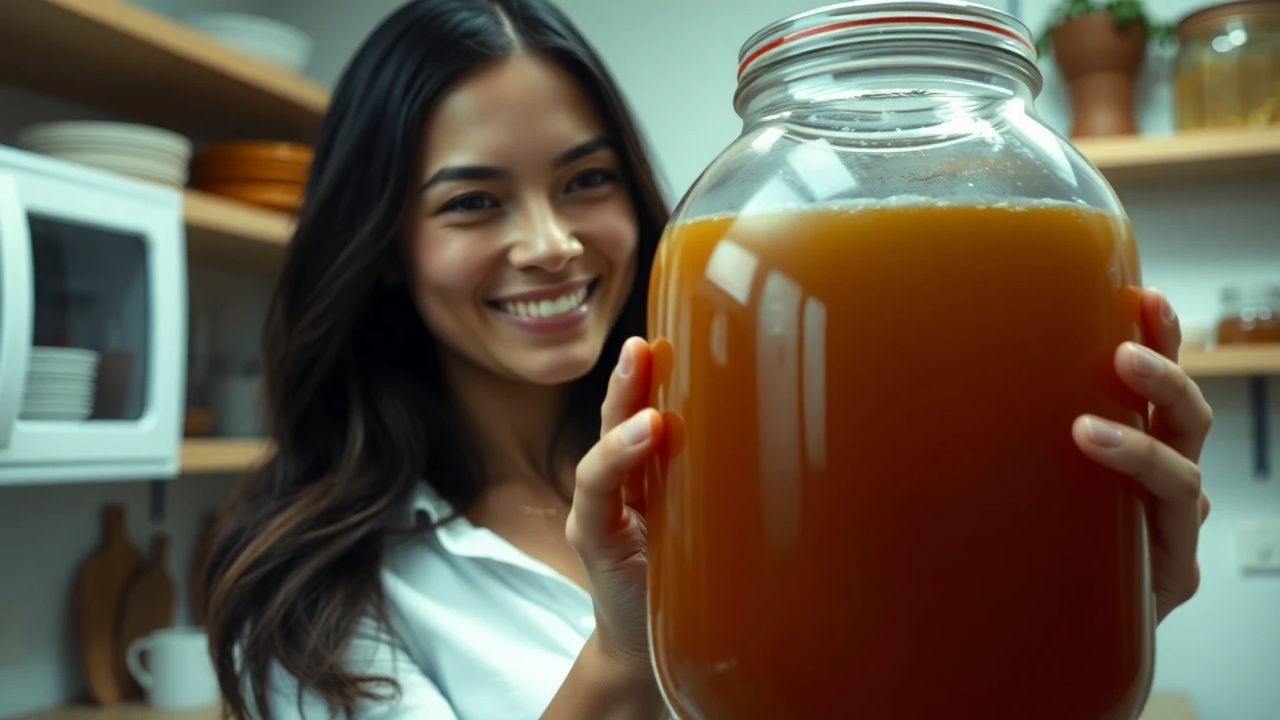Blog-Layout
Brew Your Own Kombucha at Home and REVOLUTIONIZE Your Health!
VitalFiberOne Naturals • April 1, 2025
Master the Art of Kombucha: A Guide to Brewing Your Own!

Kombucha has surged in popularity in recent years, celebrated not only for its refreshing taste but also for its numerous health benefits. Packed with probiotics, antioxidants, and beneficial enzymes, this fermented tea drink can significantly support digestive health and boost your overall wellness. Brewing kombucha at home isn't just a delightful hobby—it's a way to customize flavors, control sugar levels, and ensure quality ingredients. Ready to dive into the world of homemade kombucha? This comprehensive guide has everything you need to master the art of kombucha brewing.
Understanding Kombucha: What Exactly Is It?
Kombucha is a naturally fermented tea beverage made by combining sweet tea with a symbiotic culture of bacteria and yeast, known commonly as a SCOBY. This fermentation process transforms ordinary tea into a tangy, effervescent drink rich in probiotics, vitamins, and beneficial acids.
Health Benefits of Drinking Kombucha
Drinking kombucha regularly can:
Enhance gut health through probiotics
Support the immune system
Improve digestion
Increase energy levels
Detoxify the liver
Provide antioxidants to combat oxidative stress
Essential Kombucha Brewing Equipment
Before brewing, gather these essential items:
Large glass jar (1-2 gallons)
SCOBY (Symbiotic Culture of Bacteria and Yeast)
Starter tea (pre-brewed kombucha)
Tea (black, green, or white)
Pure cane sugar
Breathable cloth (like cheesecloth)
Rubber bands
Glass bottles for bottling
Step-by-Step Guide to Brewing Kombucha at Home
Step 1: Prepare Your Tea Base
Boil 4 cups of water.
Add 4-6 tea bags (black or green tea) and steep for 10-15 minutes.
Dissolve 1 cup of pure cane sugar in the tea while it's still warm.
Allow the tea to cool completely to room temperature.
Step 2: Ferment with SCOBY
Transfer the cooled tea into your large glass jar.
Add your SCOBY and approximately 1-2 cups of starter tea.
Cover with breathable cloth secured by a rubber band.
Place the jar in a warm, dark spot (ideally around 70-80°F).
Step 3: Fermentation Process
Allow your kombucha to ferment for 7-14 days.
Taste regularly after the first week. Longer fermentation results in a tangier, less sweet kombucha.
Step 4: Bottling and Second Fermentation
Once the desired taste is achieved, remove your SCOBY and save it for your next batch along with a cup of your kombucha as the new starter tea.
Bottle your kombucha using funnel and glass bottles, leaving some space at the top.
Add fruits, herbs, or spices at this stage for flavored kombucha.
Seal bottles and ferment for an additional 1-5 days at room temperature to achieve carbonation.
Step 5: Refrigeration and Enjoying
Refrigerate your kombucha bottles to slow fermentation and carbonation.
Serve chilled and enjoy your homemade kombucha!
Choosing the Right Ingredients
High-quality ingredients make superior kombucha. Always opt for organic tea and pure cane sugar. Avoid teas with added oils, such as Earl Grey, as they can harm your SCOBY.
Flavoring Your Kombucha
Experiment with delicious flavors by adding:
Fresh fruits like berries, mango, or pineapple
Herbs such as mint, basil, or rosemary
Spices like ginger, cinnamon, or turmeric
Adding these ingredients during bottling enhances flavor and adds additional health benefits.
Troubleshooting Common Kombucha Brewing Issues
Mold Formation
Ensure cleanliness, adequate acidity, and proper ventilation to avoid mold. Discard moldy batches and thoroughly sterilize your equipment.
Lack of Carbonation
Carbonation requires airtight bottles during the second fermentation. Adjust the amount of added sugar or fruit and increase fermentation time to improve fizz.
Too Sour or Vinegary
Shorten fermentation duration or reduce SCOBY size to prevent overly sour kombucha.
Caring for Your SCOBY
A healthy SCOBY is crucial for successful brewing:
Store SCOBY submerged in kombucha starter tea between batches.
Regularly inspect SCOBY health—healthy SCOBY should be pale beige, smooth, and without mold.
Share extra SCOBYs with friends or compost to manage SCOBY growth.
Scaling Up: Brewing Larger Batches
As your kombucha brewing skills grow, you may wish to brew larger quantities. Invest in larger vessels and consider a continuous brewing system, which simplifies the process and provides a steady supply of kombucha.
Kombucha Brewing Safety Tips
Always maintain cleanliness and sanitation.
Use glass or food-grade stainless steel containers to avoid contamination.
Monitor fermentation temperature closely.
Creative Kombucha Recipes
Boost your kombucha experience with these creative recipe ideas:
Ginger Lemon Kombucha: Add sliced ginger and fresh lemon juice during the second fermentation for a zesty, invigorating drink.
Berry Blast Kombucha: Infuse your kombucha with strawberries, raspberries, and blueberries for a sweet and antioxidant-rich beverage.
Turmeric Spice Kombucha: Blend turmeric and cinnamon for an anti-inflammatory, flavorful twist.
Frequently Asked Questions (FAQs)
How do I know when my kombucha is ready?
Taste your kombucha regularly after day 7. It should taste pleasantly tangy, slightly sweet, and mildly effervescent.
Can kombucha become alcoholic?
Yes, kombucha naturally contains small amounts of alcohol (usually less than 0.5%). Extended fermentation can slightly increase alcohol content.
How long can kombucha be stored?
Bottled kombucha stays fresh for up to 3 months in the refrigerator, though the flavor might continue to change slightly over time.
Conclusion
Brewing your own kombucha is a rewarding, healthy, and creative journey. By mastering this art, you'll enjoy endless flavor possibilities, significant health benefits, and the satisfaction of homemade wellness. Start your kombucha adventure today—your body and taste buds will thank you!

By VitalFiberOne Naturals
•
March 28, 2025
Are you tired of feeling sluggish and run down? Discover the secret to boosting your energy levels with Acacia Fiber! This natural superfood is packed with nutrients and prebiotics that help support a healthy gut, increase energy production, and even aid in weight management. In this article, we'll dive into the amazing benefits of Acacia Fiber and how you can incorporate it into your daily routine to feel more energized, focused, and vibrant. Say goodbye to fatigue and hello to a more energetic you!

By VitalFiberOne Naturals
•
March 17, 2025
Meditation has increasingly become an essential practice in our fast-paced world. For beginners, it offers a path to mental clarity, stress reduction, and inner peace. If you're new to meditation, you're in the right place! This comprehensive beginner’s guide will introduce you to easy yet effective techniques to embark on your journey towards serenity. What is Meditation? Meditation is a mindful practice that involves focusing your mind and eliminating distractions to achieve a mentally clear and emotionally calm state. Regular meditation can transform your overall wellbeing and enhance your daily life. Benefits of Meditation Reduces Stress and Anxiety: Regular meditation lowers cortisol levels, significantly reducing stress and anxiety. Improves Focus and Concentration: Meditation enhances your attention span and cognitive abilities. Enhances Emotional Health: It encourages positive thinking and emotional resilience. Boosts Physical Health: Studies link meditation to lower blood pressure, improved sleep, and better immune function. Preparing Your Meditation Space To meditate effectively, create a dedicated space that is quiet, comfortable, and free from distractions. Consider adding elements like cushions, candles, or calming decor to enhance tranquility. Choosing a Meditation Style There are several meditation styles suitable for beginners: Mindfulness Meditation: Focuses on being present and fully engaged in the current moment. Guided Meditation: Involves a teacher or recording guiding you through visualization exercises. Breath Awareness Meditation: Concentrates on mindful breathing to center the mind. Choose the style that resonates with you and your goals. Your First Meditation Session Here's a simple step-by-step guide to your first meditation: Find a Comfortable Position: Sit or lie comfortably, maintaining good posture. Set a Timer: Start with 5-10 minutes and gradually increase your session length. Close Your Eyes: Gently close your eyes to minimize visual distractions. Focus on Your Breath: Pay attention to your breathing, noticing each inhale and exhale. Gently Refocus: When your mind wanders, calmly bring your attention back to your breathing. Overcoming Common Meditation Challenges Many beginners face common challenges such as restlessness or mind wandering. Remember, these are normal experiences. Practice patience and consistency, gently guiding your focus back to your breath without judgment. How Often Should You Meditate? Consistency is key. Aim for short daily sessions of 5-15 minutes to build a sustainable meditation habit. Over time, you can gradually extend your sessions. I ncorporating Meditation into Your Daily Routine Make meditation part of your daily routine by: Meditating at the same time each day Pairing meditation with existing habits, like after your morning coffee or before bedtime Using reminders or alarms to keep consistent Utilizing Technology in Meditation Leverage meditation apps or guided online sessions to enhance your practice. Popular apps like Calm, Headspace, or Insight Timer offer beginner-friendly resources to support your journey. Meditation and Physical Activity Pairing meditation with physical activities such as yoga or walking can amplify its benefits, creating a holistic wellness routine that supports both mind and body. Tracking Your Meditation Progress Keeping a meditation journal or using an app to track sessions helps visualize progress, boosting motivation and consistency. Common Myths About Meditation Meditation Requires Hours: Effective meditation can happen in just a few minutes each day. You Must Completely Clear Your Mind: Meditation is about observing thoughts without judgment, not eliminating them entirely. Dispelling these myths helps create realistic expectations and ensures a rewarding meditation experience. Conclusion: Embrace Your Journey to Serenity Meditation offers profound benefits even in small, consistent doses. With these foundational steps, you’re now ready to cultivate mindfulness, reduce stress, and enhance your overall wellness. Begin today, and discover the path to lasting serenity.

By VitalFiberOne Naturals Inc.
•
February 8, 2025
Revolutionize your diabetes care with the power of AI! Introducing GlucoAI Precision Technology, a game-changing innovation that's transforming the way we manage diabetes. This cutting-edge technology uses artificial intelligence to provide personalized insights and precise glucose monitoring, empowering individuals to take control of their health. Say goodbye to guesswork and hello to data-driven decision making. Learn how GlucoAI is revolutionizing diabetes care and improving lives.

By VitalFiberOne Naturals Inc.
•
January 24, 2025
Making grocery shopping a breeze for diabetics! GlucoSense is revolutionizing the way people with diabetes shop for groceries. With its innovative technology, GlucoSense makes it easy to identify and purchase diabetes-friendly food products. Say goodbye to hours of research and label-reading, and hello to a stress-free shopping experience. In this video, we'll show you how GlucoSense is changing the game for diabetics and making healthy grocery shopping a whole lot easier. Whether you're living with diabetes or know someone who is, this video is a must-watch!








